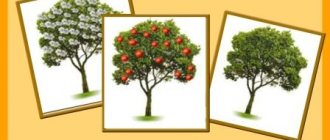Summary of a lesson on appliqué for middle group children: “Vegetables in a shopping cart”
Topic: "Vegetables in the shopping cart"
Goal: To consolidate the name and characteristic features of vegetables; strengthen skills in working with scissors and glue; learn to create a simple composition on a sheet of paper, stick them on yourself; continue to develop the ability to accurately follow the teacher's verbal instructions.
Objectives: To lead children to understand the general concept of “Vegetables”;
Give an idea about the store. About the fact that stores are different.
Methods and techniques: Verbal (riddles); practical (modeling); visual (viewing a presentation).
Preliminary work:
Examination of the finished sample.
Reading poetry.
Literary series:
Eat vegetables and fruits!
Eat vegetables and fruits - These are the best foods. You will be saved from all diseases. There is nothing tastier and healthier than them.
Make friends with vegetables, And with salads and cabbage soup. There are countless vitamins in them. So you need to eat it!
N. Dovzhenko
The carrot grew delicious, a very long head, orange color, sunny summer. The tail sticks out above the ground and says to the guys: Show some skill, get out the carrots. Tasty and sweet , but don’t eat it on the sly. Wash it very thoroughly, everything will be fine
M. Borina
E. Zhukovskaya I am long and green, Sometimes fresh, sometimes salty, I grow in the garden, am loved by all the people, That’s how good I am, I’m called a cucumber.
E. Zhukovskaya
I am a tomato, or a tomato, am rich in vitamins, I am not terrible in appearance: I am round and red, Everyone will be very happy to put me in a salad
E. Zhukovskaya
Pepper is a multi-colored vegetable. It is green, yellow, red, and orange in color, and in different sizes and shapes. Choose what suits you and pack it for breakfast.
Svetlana Alexandrova
Demonstration and handout material:
Microsoft PowerPoint presentation;
Sheets of colored paper with images of vegetables (cucumber, carrots, tomato, pepper);
A sheet of white A5 paper with an image of a shopping cart;
Scissors;
Glue;
Glue brush;
Rugs.
Progress of the lesson:
1.Organizing moment.
Educator: Guys, Dunno came to visit us today.
Dunno: Hello, guys!
I decided to treat my friends to healthy, vitamin-rich foods – vegetables, but I don’t know what they are called. I came to you for help, could you go with me to the store, choose vegetables and tell me what they are called.
Educator: Dunno, what is the name of the store that sells vegetables?
Dunno: I don’t know! Everyone laughs at me, they say that I, Dunno, don’t know anything! And I'm very ashamed.
Teacher, let's help Dunno and tell us what kind of stores there are.
- Guys, what is the name of the store that sells cottage cheese and milk?
Children's answers - milk
Educator: What is the name of the store that sells bread, loaves, sweet pastries?
Children's answers: bread
Educator: What is the name of the store that sells vegetables and fruits?
Children's answer: vegetable
Educator: That's right, guys, now Dunno and I will go to a grocery store, but not a simple one, but the one that I will show you on the computer screen. I will tell you riddles about vegetables, and you will guess them, and then we will see a picture with the correct answer.
View presentation:
Main part.
Educator: So we guys, together with Dunno, visited a vegetable store, helped him choose vegetables and find out their name, now Dunno will treat his friends with delicious and healthy vegetables.
- Guys, come on, let’s treat Dunno with vegetables. I suggest you take a shopping cart, remember what vegetables you and I saw in the store and fill the cart with them.
Independent work of children
Cut out an image of vegetables from colored paper along the contour.
Glue the vegetables onto the shopping cart template, identifying the correct location for each vegetable.
Our work is ready. The cart is filled with juicy and healthy vegetables for Dunno.
Reflection
At the end of the lesson, review the children’s work and give each child a positive assessment.
– You all did a great job today: you carefully cut out and pasted the vegetables.
– Now show your works to each other and tell us about them, tell us:
- What is the name of the store that sells vegetables?
— what vegetables did you get acquainted with?
— what did you learn today?
— what was interesting to know?
— what was difficult?
-What didn’t work out and why?
- what worked best?
- Who would you like to thank for your work in class?
MAGAZINE Preschooler.RF
Summary of direct educational activities for children of the middle group “Vegetables in a jar”in the educational field “Artistic and aesthetic development” (module “Implementation of independent creative activity of children in visual arts” )
Authors:
- Plotnikova Antonina Sergeevna - teacher
- Pavlova Elena Leonidovna - head
MBDOU "Kindergarten No. 3" Cheboksary
Goal: To consolidate children's knowledge about vegetables and their preparation for the winter.
Tasks:
- Educational: summarize children’s ideas about the shape, color, size of vegetables. Learn to distinguish and name vegetables. Introduce an unconventional drawing technique: stamping with a sponge through a stencil.
- Developmental: develop sensory sensations, imagination.
- Educational: to cultivate accuracy in working with paints, to make children want to help the heroes in a difficult situation. Continue to develop the ability to perform certain actions according to the verbal instructions of the teacher.
Demonstration material: letter, 2-3 baskets of dummies of tomatoes and cucumbers, grandmother’s house, easel.
Handouts: landscape paper cut in the shape of a jar, stencils of cucumbers, tomatoes, foam rubber stamps, gouache paints in red and green colors, colored crayons, felt-tip pen, rag napkins, wet wipes, house, gouache plates, envelope, tape recorder.
Vocabulary work: preserve, prepare.
Individual work: providing assistance to children as needed.
Preliminary work: conversation about vegetables grown in the garden, harvesting in the autumn.
Reading literary fairy talesK. Chukovsky’s “Fedorino’s Mountain”, V. Suteev’s “Sack of Apples”, Y. Tuvim’s poem “Vegetables”.
Examination of pictures, posters, plot pictures on the topic “Vegetables”.
D/i “The fourth odd one”, “Tops and roots”, “What grows where” .
Methodical techniques:
- Greetings.
- Surprise moment “Letter from Grandma Fedora” .
- Game motivation “We’re going to the village to help grandma .
- Demonstration and explanation by the teacher of non-traditional sponge painting.
- Finger gymnastics “Cabbage” .
- Children doing their own work.
- Individual assistance to those in need.
- Children's analysis of their work.
- Analysis of children's activities.
The progress of educational activities directly.
Introductory part.
Educator: -Today is a good day,
Let's smile at each other.
And with such a good mood
Let's say hello to our guests.
Let's say "Good morning!" or “Hello!”
Children: - Hello!
Educator: -Guys, today the postman brought an interesting letter to our group. (shows to children). Who do you think it could be from? (from grandmother Fedora). How did you guess? What told you? (on the envelope there are scenes from K. Chukovsky’s fairy tale “Fedorino’s Grief” ). Would you like to hear what our friend Grandma Fedora wrote to us?
“Hello, my dear guys! Summer has flown by and autumn has arrived. And I immediately had a lot to do in the garden: before the onset of cold weather, I harvested the entire harvest. I need to preserve them in jars. I can't handle it alone. Come and help me please. I'll be looking forward to seeing you all! With love, your grandmother Fedora."
Vocabulary work: preserve.
Teacher - Guys, how do you understand the word “preserve” ? (children's answers: close for the winter in jars for long-term storage). Dasha, (names of 2-3 children) repeat the word “preserve” . Sasha, what can you preserve? Lera, what can you use to preserve vegetables? Safina, why do people can can vegetables?
Game motivation.
Educator: - Guys, can we help Grandma Fedora? We go to the village to visit our grandmother. But the road is long, we cannot do without magic here. To do this, I suggest closing your eyes, spinning around and saying the magic words “Spin, spin, find yourself visiting grandma . (fairytale music sounds). Open your eyes. So we were transported to Grandma Fedora’s yard. (The house, and in front of it there are baskets of tomatoes and cucumbers).
Guys, look how big and beautiful the grandmother’s garden is. What vegetables do you see here? What shape, color, size, taste are they? But my grandmother is not at home, she probably went for help. We need to help Grandma Fedora preserve the harvest. Guys, Fedora’s grandmother offers to preserve all these vegetables in jars. Has anyone seen your parents do this? (children's answers).
Main part.
Educator: - Let's help Grandma Fedora. Now I will show you how this can be done (showing and explaining the teacher).
Come in, sit down on the carpet.
I take a jar, put a tomato stencil on the jar, hold it with my left hand, and take a sponge in my right hand, dip it in red paint, and begin using the dipping method to carefully paint the vegetable - the tomato. I fill the entire jar with tomatoes, and then close the jar with a lid, drawing a line on top with a brush, and my workpiece is ready.
Before you start working, I suggest you stretch your fingers.
Finger gymnastics “Cabbage” .
We chop and chop the cabbage (Make sharp movements with straight hands up and down.)
We are three carrots, three (Clench your fingers into fists, move your fists towards you and away from you.)
We salt the cabbage, salt it (Make movements with your fingers, sprinkle salt from a pinch.)
We squeeze the cabbage, squeeze it (Intensely clench your fingers into a fist.)
Now I suggest you go and sit at the tables to make your preparations.
Educator: – You have everything you need for work on your tables. Jar templates, cucumber and tomato stencils, red and green paints, napkins.
We place the stencils on the free space in the jar and continue to paint the vegetables as desired.
(At the end, as they finish their work, the children analyze their work and hang it on a magnetic board).
Final part.
Educator: - What great fellows you all are! What did you do today? What did you like most? What vegetables are in their jars? How did we help grandma? We need to tidy up our workspaces, clean our hands with napkins.
(Children's answers).
Educator: - Grandma Fedora will come, see the preparations and be very happy. It's time for us to go back to kindergarten. We close our eyes to the magic words “Turn around, turn around, you’ll find yourself in kindergarten!” We return to kindergarten.
Literature:
- “From birth to school” Approximate basic general education program for preschool education / ed. NOT. Veraksy, T.S. Komarova, M.A. Vasilyeva. – M.: “MOSAIC – SYNTHESIS” , 2014.
- Komarova T.S. Visual activities in kindergarten. - M.: Pedagogy, 1990.
- Lykova I.A. “Art activities in kindergarten. Middle group" . - M.: “Karapuz” , 2009.
- Drawing with preschool children: non-traditional techniques, planning, lesson notes. / Ed. Kazakova R.G. – M.: Sphere , 2005.
- Nikitina A.V. “Non-traditional drawing techniques in preschool educational institutions. A manual for educators and parents . – St. Petersburg: KARO, 2007.
Application
| Next > |



